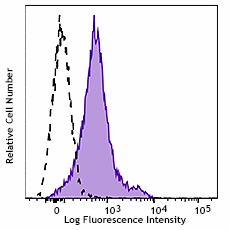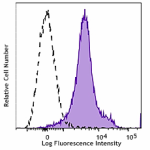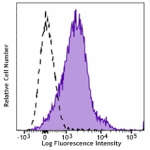- Clone
- MIH7 (See other available formats)
- Regulatory Status
- RUO
- Other Names
- Programmed cell death ligand 1 (PD-L1), B7 homolog 1 (B7-H1), B7-H, B7H1, PDL1, PDCD1L1, PDCD1LG1
- Isotype
- Rat IgG2a, λ
- Ave. Rating
- Submit a Review
- Product Citations
- publications

-

C57BL/6 mouse splenocytes were stained with Purified CD274 (clone MIH7, filled histogram) or purified rat IgG2a, κ isotype control (open histogram), followed by anti-Rat IgG PE.
| Cat # | Size | Price | Quantity Check Availability | Save | ||
|---|---|---|---|---|---|---|
| 155402 | 500 µg | 113€ | ||||
CD274, also known as B7-H1 or programmed death ligand 1 (PD-L1), is a 40 kD type I transmembrane protein and a member of the B7 family within the immunoglobulin receptor superfamily. It is expressed on T cells, B cells, NK cells, dendritic cells, IFN-γ activated endothelial cells, and monocytes. B7-H1 is one of the ligands of PD-1. The interaction of B7-H1 with PD-1 plays an important role in the inhibition of T cell responses. Other studies have shown that B7-H1 is able to costimulate T cell growth and cytokine production. CD274 is involved in costimulation essential for T cell proliferation and production of IL-10 and IFN-γ, in an IL-2-dependent and a PD-1-independent manner. Its interaction with PD-1 inhibits T cell proliferation and cytokine production.
Product DetailsProduct Details
- Verified Reactivity
- Mouse
- Antibody Type
- Monoclonal
- Host Species
- Rat
- Immunogen
- Mouse PD-L1 transfectant
- Formulation
- Phosphate-buffered solution, pH 7.2, containing 0.09% sodium azide.
- Preparation
- The antibody was purified by affinity chromatography.
- Concentration
- 0.5 mg/ml
- Storage & Handling
- The antibody solution should be stored undiluted between 2°C and 8°C.
- Application
-
FC - Quality tested
Block - Reported in the literature, not verified in house - Recommended Usage
-
Each lot of this antibody is quality control tested by immunofluorescent staining with flow cytometric analysis. For flow cytometric staining, the suggested use of this reagent is ≤ 1.0 µg per million cells in 100 µl volume. It is recommended that the reagent be titrated for optimal performance for each application.
- Application Notes
-
The antibody MIH7 does not block other CD274 antibodies: clone MIH6 and 10F.9G2.
Additional reported applications (for the relevant formats) include: Blocking (Block) - Application References
-
- Sharma MD, et al. 2007. J Clin Invest. 117:2570-82. (Block)
- Sharma MD, et al. 2015. Sci Adv. 1:e1500845. (Block)
- Product Citations
-
- RRID
-
AB_2800692 (BioLegend Cat. No. 155402)
Antigen Details
- Structure
- Type 1 transmembrane protein, member of the B7 family, 40kD.
- Distribution
-
T cells, B cells, NK cells, dendritic cells, IFN-γ activated endothelial cells, and monocytes
- Function
- CD274 is involved in the costimulatory signal, essential for T lymphocyte proliferation and production of IL-10 and IFN-γ, in an IL-2-dependent and a PD-1-CD1-independent manner. Its interaction with PD-1-CD1 inhibits T-cell proliferation and cytokine production.
- Ligand/Receptor
- PD-1 (CD279)
- Cell Type
- B cells, Dendritic cells, Endothelial cells, Monocytes, T cells
- Biology Area
- Cancer Biomarkers, Costimulatory Molecules, Immuno-Oncology, Immunology
- Molecular Family
- Adhesion Molecules, CD Molecules, Immune Checkpoint Receptors
- Antigen References
-
- Dorand RD. 2016. Science. 353:399
- Khan AR, et al. 2015. Nat Commun. 6:5997
- Kiyasu J, et al. 2015. Blood. 126:2193
- Herold M, et al. 2015 J Immunol. 195:3584
- Buddhisa S, et al. 2015. J Immunol. 194:4413
- Gene ID
- 60533 View all products for this Gene ID
- UniProt
- View information about CD274 on UniProt.org
Related FAQs
Other Formats
View All CD274 Reagents Request Custom Conjugation| Description | Clone | Applications |
|---|---|---|
| PE anti-mouse CD274 (B7-H1, PD-L1) | MIH7 | FC |
| Purified anti-mouse CD274 (B7-H1, PD-L1) | MIH7 | FC |
| PE/Cyanine7 anti-mouse CD274 (B7-H1, PD-L1) | MIH7 | FC |
Compare Data Across All Formats
This data display is provided for general comparisons between formats.
Your actual data may vary due to variations in samples, target cells, instruments and their settings, staining conditions, and other factors.
If you need assistance with selecting the best format contact our expert technical support team.
-
PE anti-mouse CD274 (B7-H1, PD-L1)

C57BL/6 mouse splenocytes were stained with CD274 (clone MIH... -
Purified anti-mouse CD274 (B7-H1, PD-L1)

C57BL/6 mouse splenocytes were stained with Purified CD274 (... -
PE/Cyanine7 anti-mouse CD274 (B7-H1, PD-L1)

C57BL/6 mouse splenocytes were stained with CD274 (B7-H1, PD...
 Login / Register
Login / Register 








Follow Us